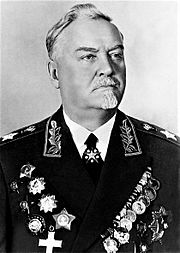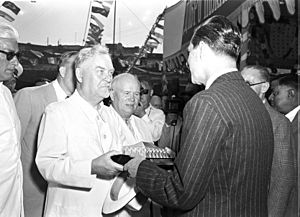Nikolai Bulganin facts for kids
Quick facts for kids
Nikolai Bulganin
|
|||||||||||||||||||||||||||||||||||||||||||||||
|---|---|---|---|---|---|---|---|---|---|---|---|---|---|---|---|---|---|---|---|---|---|---|---|---|---|---|---|---|---|---|---|---|---|---|---|---|---|---|---|---|---|---|---|---|---|---|---|
|
Николай Булганин
|
|||||||||||||||||||||||||||||||||||||||||||||||

Bulganin in 1955
|
|||||||||||||||||||||||||||||||||||||||||||||||
| 6th Premier of the Soviet Union | |||||||||||||||||||||||||||||||||||||||||||||||
| In office 8 February 1955 – 27 March 1958 |
|||||||||||||||||||||||||||||||||||||||||||||||
| President | Kliment Voroshilov | ||||||||||||||||||||||||||||||||||||||||||||||
| First Deputies | Anastas Mikoyan Mikhail Pervukhin Maksim Saburov Joseph Kuzmin Lazar Kaganovich |
||||||||||||||||||||||||||||||||||||||||||||||
| Preceded by | Georgy Malenkov | ||||||||||||||||||||||||||||||||||||||||||||||
| Succeeded by | Nikita Khrushchev | ||||||||||||||||||||||||||||||||||||||||||||||
| Minister of Defence (Soviet Union) |
|||||||||||||||||||||||||||||||||||||||||||||||
| In office 15 March 1953 – 9 February 1955 |
|||||||||||||||||||||||||||||||||||||||||||||||
| Premier | Georgy Malenkov | ||||||||||||||||||||||||||||||||||||||||||||||
| Preceded by | Aleksandr Vasilevsky Nikolai Kuznetsov |
||||||||||||||||||||||||||||||||||||||||||||||
| Succeeded by | Georgy Zhukov | ||||||||||||||||||||||||||||||||||||||||||||||
|
|||||||||||||||||||||||||||||||||||||||||||||||
| Personal details | |||||||||||||||||||||||||||||||||||||||||||||||
| Born |
Nikolai Alexandrovich Bulganin
(Никола́й Алекса́ндрович Булга́нин) 11 June 1895 Nizhny Novgorod, Russian Empire |
||||||||||||||||||||||||||||||||||||||||||||||
| Died | 24 February 1975 (aged 79) Moscow, Russian SFSR, Soviet Union |
||||||||||||||||||||||||||||||||||||||||||||||
| Resting place | Novodevichy Cemetery, Moscow | ||||||||||||||||||||||||||||||||||||||||||||||
| Citizenship | Soviet | ||||||||||||||||||||||||||||||||||||||||||||||
| Nationality | Russian | ||||||||||||||||||||||||||||||||||||||||||||||
| Political party | Communist Party of the Soviet Union (1917–1960) | ||||||||||||||||||||||||||||||||||||||||||||||
| Awards | Hero of Socialist Labour | ||||||||||||||||||||||||||||||||||||||||||||||
| Religion | Russian Orthodox convert to Atheism | ||||||||||||||||||||||||||||||||||||||||||||||
| Military service | |||||||||||||||||||||||||||||||||||||||||||||||
| Allegiance | |||||||||||||||||||||||||||||||||||||||||||||||
| Branch/service | Red Army | ||||||||||||||||||||||||||||||||||||||||||||||
| Years of service | 1941–1958 | ||||||||||||||||||||||||||||||||||||||||||||||
| Rank | Marshal of the Soviet Union (1947–1958) | ||||||||||||||||||||||||||||||||||||||||||||||
| Commands | Soviet Armed Forces | ||||||||||||||||||||||||||||||||||||||||||||||
| Battles/wars | World War II | ||||||||||||||||||||||||||||||||||||||||||||||
Nikolai Alexandrovich Bulganin (Russian: Никола́й Алекса́ндрович Булга́нин; 11 June 1895 – 24 February 1975) was an important Soviet politician. He served as the Minister of Defense from 1953 to 1955. Later, he became the Premier of the Soviet Union (like a prime minister) from 1955 to 1958. He worked closely with Nikita Khrushchev during this time. Before these roles, he was also involved with the Red Army and served under Joseph Stalin.
Contents
Early Life and Political Beginnings
Nikolai Bulganin was born in 1895 in Nizhny Novgorod, a city in Russia. His father was an office worker. In March 1917, he joined the Bolshevik Party, a political group that later took control of Russia.
In 1918, Bulganin joined the Cheka, which was the Bolshevik government's secret police. He worked there until 1922. During this time, he helped enforce strict rules in Nizhny Novgorod. After the Russian Civil War (1917-1923), Bulganin started working in industry. He managed electricity supply in Moscow from 1927 to 1931. From 1931 to 1937, he was like the mayor of Moscow.
Rising Through the Ranks
Bulganin quickly rose in power because he was loyal to Joseph Stalin. Many other leaders were removed during Stalin's "Great Purge" in the late 1930s. In July 1937, Bulganin became the Chairman of the Council of People's Commissars for the Russian Soviet Federative Socialist Republic (RSFSR). This was like being the prime minister of that part of the Soviet Union.
Later that year, he became a full member of the Communist Party's Central Committee. In September 1938, he was made Deputy Prime Minister of the Soviet Union. He also became the head of the State Bank of the USSR (Gosbank).
Role in World War II
During World War II, Bulganin played a key role in the government and the Red Army. However, he was not a commander on the front lines. Instead, he served as a chief political commissar. His job was to ensure that military leaders followed the Communist Party's policies.
He held similar political roles in the army until July 1944. Then, he became the Soviet representative to the Polish Committee of National Liberation. In November 1944, he was promoted to the rank of General. He also became the USSR Deputy Minister for Defence, working under Joseph Stalin, who was the Minister.
Post-War Promotions
After the war, Bulganin continued to gain power. In March 1946, he became a candidate member of the Politburo. The Politburo was the main decision-making body of the Communist Party. In March 1947, he took over from Stalin as Minister for the Armed Forces. He was also Deputy Prime Minister of the Soviet Union again from 1947 to 1950.
In November 1947, he reached the highest military rank: Marshal of the Soviet Union. By February 1948, he became a full member of the Politburo.
Bulganin's Personality and Military Role
Even though Bulganin became a Marshal, he was mainly a political officer, not a battlefield commander. His main job was to make sure that powerful military leaders, like Georgy Zhukov, did not become too strong and challenge Stalin. Some people who worked with him felt he didn't understand basic military ideas very well.
In March 1949, a professional soldier, Aleksandr Vasilevsky, replaced Bulganin as Minister for Defence. After that, Bulganin was put in charge of the arms industry.
Becoming Premier of the Soviet Union
After Stalin died in March 1953, Bulganin became one of the top leaders in the Soviet Union. He was again appointed Minister of Defense, with Marshal Zhukov as his deputy. He supported Nikita Khrushchev in his struggle for power against Georgy Malenkov. In February 1955, Bulganin replaced Malenkov as the Premier of the Soviet Union.
He was generally seen as someone who supported Khrushchev's changes. These changes included "De-Stalinization," which meant moving away from Stalin's harsh policies.
International Travels and the "B and K Show"
In July 1955, Bulganin attended the Geneva Summit. He met with leaders like U.S. President Dwight D. Eisenhower and British Prime Minister Anthony Eden. He and Khrushchev often traveled together to other countries, like India, Yugoslavia, and Britain. In the news, they were sometimes called "the B and K show" or "Bulge and Crush."
During the Suez Crisis in 1956, Bulganin sent letters to the governments of the United Kingdom, France, and Israel. He threatened rocket attacks if they did not remove their forces from Egypt. However, Khrushchev later said this threat was mostly a bluff to create disagreements among Western countries. The Soviet Union didn't have enough long-range missiles to carry out such an attack at that time.

Losing Power
By 1957, Bulganin started to have doubts about Khrushchev's policies. He began to agree with a group of leaders who opposed Khrushchev. This group was called the "Anti-Party Group" by Khrushchev's supporters. When this group tried to remove Khrushchev from power, Bulganin seemed unsure which side to support.
After the group failed, Bulganin kept his job for a short time. But in March 1958, Khrushchev forced him to resign. Bulganin was given a less important job as Chairman of the Soviet State Bank. Later, in August, he was sent to a less important role in Stavropol. In November, he was removed from the Politburo. By September, he was no longer part of the Central Committee and lost his military rank of Marshal. In February 1960, he retired with a pension.
Personal Life and Death
Nikolai Bulganin was married to Elena Mikhailovna Korovina, who was an English teacher. They had two children, a son named Leo and a daughter named Vera. Vera married the son of Admiral Nikolai Kuznetsov.
Bulganin passed away on February 24, 1975, at the age of 79, after a long illness. He was buried in the Novodevichy Cemetery in Moscow.
Honours and Awards
| Hero of Socialist Labour (10 June 1955) | |
| Orders of Lenin, twice (1931, 1955) | |
| Order of the Red Banner (1943) | |
| Order of Suvorov, 1st class (1945) and 2nd class (1943) | |
| Order of Kutuzov, 1st class, twice (1943, 1944) | |
| Order of the Red Star, twice (1935, 1953) | |
| Order of the Republic (Tuvan People's Republic, 3 March 1942) | |
| Grand Cross of the Virtuti Militari (Poland) |
See also
- In Spanish: Nikolái Bulganin para niños
- Stalin: Waiting for Hitler, 1929-1941



